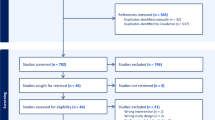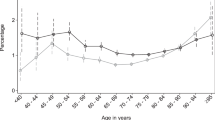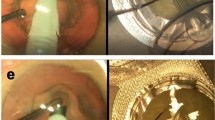Abstract
Purpose
To evaluate the safety of an intensive cataract surgery training programme.
Methods
An intensive cataract surgery training programme was implemented in August 2010 for year 3 ophthalmology trainees in the East Midlands Deanery North Rotation (United Kingdom). Trainees participated in extra-ocular surgery and 50 h of virtual reality cataract surgery simulator training over a 2-year period. Their third year comprised 6 months of intensive phacoemulsification training in a tertiary centre followed by a 6-month period of consolidation in a district general hospital. The complication rates and case numbers were evaluated after the first 2 years of implementation.
Results
At 2 years, three trainees had completed a full year of intensive training. In the first 6 months of training, Trainee 1 completed 156 cases, Trainee 2 completed 194 cases, and Trainee 3 completed 151 full cases as primary surgeons with an average rate of posterior capsule rupture (PCR) of 1%. At 12 months, Trainee 1 completed 291, Trainee 2 completed 318, and Trainee 3 completed 294 cases, with an average PCR rate of 0.66%. The trainees required 84 lists on average to complete 150 full cataract procedures.
Conclusion
The combination of simulation and the new intensive training programme is safer than the traditional programme for cataract surgery training.
Similar content being viewed by others
Log in or create a free account to read this content
Gain free access to this article, as well as selected content from this journal and more on nature.com
or
References
RANZCO. [cited 2011 Available from http://www.ranzco.edu/index.php/media-releases/88-the-continuing-evolution-of-modern-cataract-surgery.
Johnston RL, Taylor H, Smith R, Sparrow JM . The Cataract National Dataset electronic multi-centre audit of 55,567 operations: variation in posterior capsule rupture rates between surgeons. Eye 2010; 24 (5): 888–893.
Ross M-A, Avery AJ, Foss AJE . Views of older people on cataract surgery options: an assessment of preferences by conjoint analysis. Qual Saf Health Care 2003; 12 (1): 13–17.
Narendran N, Jaycock P, Johnston RL, Taylor H, Adams M, Tole DM et al. The Cataract National Data set electronic multicentre audit of 55,567 operations: risk stratification for posterior capsule rupture and vitreous loss. Eye 2009; 23 (1): 31–37.
Henderson BA, Ali R . Teaching and assessing competence in cataract surgery. Curr Opin Ophthalmol 2007; 18 (1): 27–31.
Lee A . Teaching and assessing surgical competency in ophthalmology. Ophthalmology 2006; 113 (12): 2380–2381.
Dooley IJ, O’Brien PD . Subjective difficulty of each stage of phacoemulsification cataract surgery performed by basic surgical trainees. J Cataract Refract Surg 2006; 32 (4): 604–608.
Martin KR, Burton RL . The phacoemulsification learning curve: per-operative complications in the first 3000 cases of an experienced surgeon. Eye 2000; 14 (Pt 2): 190–195.
Thomas R, Braganza A, Raju R, Lawrence SpitzerKH . Phacoemulsification--a senior surgeon’s learning curve. Ophthalmic Surg 1994; 25 (8): 504–509.
Carricondo PC, Fortes ACFM Mourão, P de C, Hajnal M, Jose NK . Senior resident phacoemulsification learning curve (corrected from cure). Arq Bras Oftalmol 2010; 73 (1): 66–69.
Ionides A, Minassian D, Tuft S . Visual outcome following posterior capsule rupture during cataract surgery. Br J Ophthalmol 2001; 85 (2): 222–224.
Randleman JB, Wolfe JD, Woodward M, Lynn MJ, Cherwek DH, Srivastava SK . The resident surgeon phacoemulsification learning curve. Arch Ophthalmol. 2007; 125 (9): 1215–1219.
Rogers GM, Oetting TA, Lee AG, Grignon C, Greenlee E, Johnson AT et al. Impact of a structured surgical curriculum on ophthalmic resident cataract surgery complication rates. J Cataract Refract Surg 2009; 35 (11): 1956–1960.
Lundström M, Behndig A, Kugelberg M, Montan P, Stenevi U, Thorburn W . Decreasing rate of capsule complications in cataract surgery: eight-year study of incidence, risk factors, and data validity by the Swedish National Cataract Register. J Cataract Refract Surg 2011; 37 (10): 1762–1767.
McPhee JT, Robinson WP 3rd, Eslami MH, Arous EJ, Messina LM, Schanzer A . Surgeon case volume, not institution case volume, is the primary determinant of in-hospital mortality after elective open abdominal aortic aneurysm repair. J. Vasc. Surg. 2011; 53 (3): 591–599, e2.
Begg CB, Riedel ER, Bach PB, Kattan MW, Schrag D, Warren JL et al. Variations in morbidity after radical prostatectomy. N Engl J Med. 2002; 346 (15): 1138–1144.
Schrag D, Panageas KS, Riedel E, Cramer LD, Guillem JG, Bach PB et al. Hospital and surgeon procedure volume as predictors of outcome following rectal cancer resection. Ann Surg 2002; 236 (5): 583–592.
McGrath PD, Wennberg DE, Dickens JD Jr, Siewers AE, Lucas FL, Malenka DJ et al. Relation between operator and hospital volume and outcomes following percutaneous coronary interventions in the era of the coronary stent. JAMA 2000; 284 (24): 3139–3144.
Ericsson KA . Deliberate practice and the acquisition and maintenance of expert performance in medicine and related domains. Acad Med 2004; 79 (10 Suppl): S70–S81.
Accreditation Council for Graduate Medical Education. Available from: http://www.acgme.org/acWebsite/RRC_240/NAT_REPT_National_Report_Program_Version.pdf.
Acknowledgements
We thank Intensive Cataract Training Study Group: Trainers—Professor Stephen A Vernon, Mr Senthil Maharajan, Mr Dharmalingham Kumudhan, Mr Shery Thomas, Mrs Sushma Dhar-Munshi, Mr Srinivasan Subramaniam, Mr Marius Scheepers, Mr Arun Lakshmanan, Mrs Prema Maharajan, Mr Timothy Steel, Mr Philip Alexander, Mr Nainglatt Tint, and Mr James Tildsley. Active support was obtained from the Deanery: Dr David Williams. Other Contributors who allowed timetable reorganisation are: Mrs Lorraine Abercrombie, Mr Winfried Amoaku, Professor Harminder Dua, Mr Richard Gregson, Mr Anthony King, Miss Chea Lim, Mrs Vineeta Munshi, Mr Ponniah Nithianandan, Mr Gavin Orr, Mrs Katya Tambe, and Mr Anwar Zaman. Funds for purchasing the simulator were from the Queens Medical Centre and charitable funds.
Author information
Authors and Affiliations
Consortia
Corresponding author
Ethics declarations
Competing interests
The authors declare no conflict of interest.
Additional information
This work been presented as a poster at the Royal College of Ophthalmologists Annual Congress 2012.
Contributors Stephen A Vernon, Senthil Maharajan, Dharmalingham Kumudhan, Shery Thomas, Sushma Dhar-Munshi, Srinivasan Subramaniam, Marius Scheepers, Arun Lakshmanan, Prema Maharajan, Timothy Steel, Philip Alexander, Nainglatt Tint, James Tildsley, David Williams, Lorraine Abercrombie, Winfried Amoaku, Harminder Dua, Richard Gregson, Anthony King, Chea Lim, Vineeta Munshi, Ponniah Nithianandan, Gavin Orr, Katya Tambe, Anwar Zaman
Rights and permissions
About this article
Cite this article
Baxter, J., Lee, R., Sharp, J. et al. Intensive cataract training: a novel approach. Eye 27, 742–746 (2013). https://doi.org/10.1038/eye.2013.54
Received:
Accepted:
Published:
Issue date:
DOI: https://doi.org/10.1038/eye.2013.54
Keywords
This article is cited by
-
A model for anterior vitrectomy in real patients: Simulation for practical training
Eye (2024)
-
Principles of simulation and their role in enhancing cataract surgery training
Eye (2022)
-
Cataract surgery risk stratification in phacoemulsification and manual small incision cataract surgery in a teaching hospital
International Ophthalmology (2022)
-
A systematic review of simulation-based training tools for technical and non-technical skills in ophthalmology
Eye (2020)
-
Quantifying the real-world cost saving from using surgical adjuncts to prevent complications during cataract surgery
Eye (2018)



